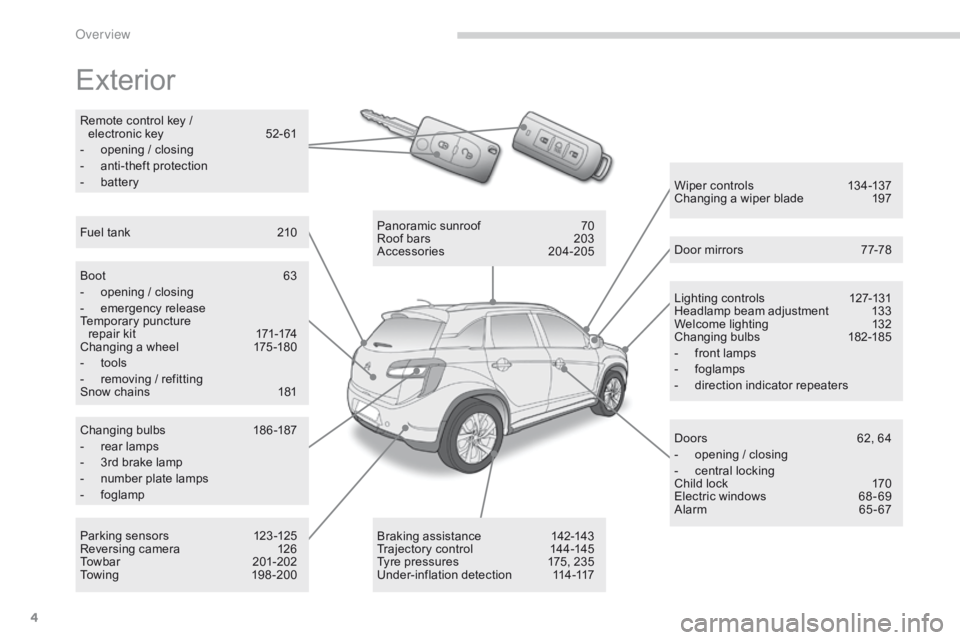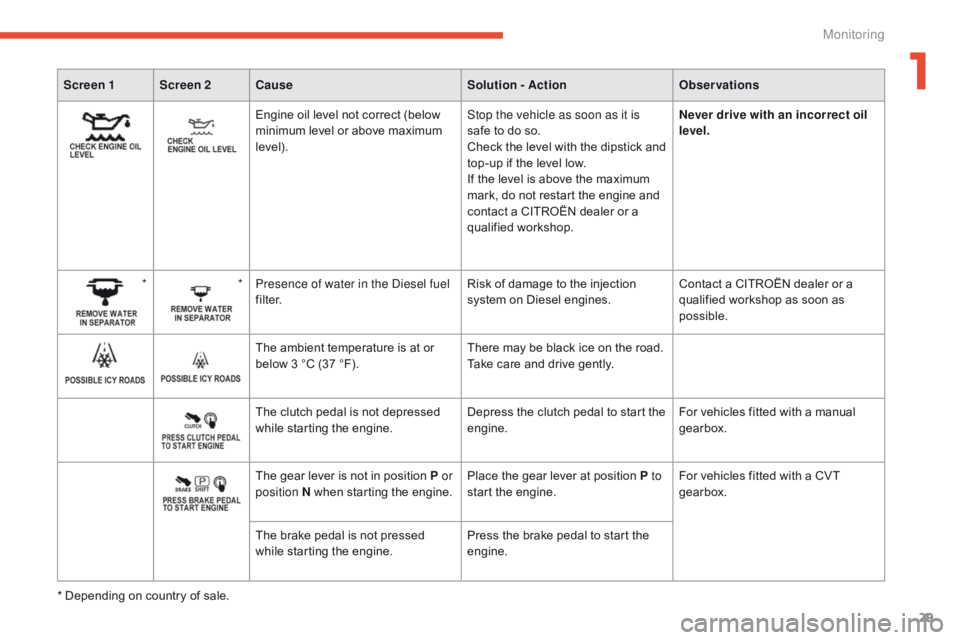Page 5 of 414

Direction indicators 141
Hazard warning lamps
1
41
H o r n
1
41
Braking assistance systems
1
42
Trajectory control systems
1
44
Front seat belts
1
46
Airbags
1
50
Child seats
1
55
Deactivating the passenger's front airbag
1
57
ISOFIX child seats
1
64
Child lock
1
70
Safety
Temporary puncture repair kit 1 71
Changing a wheel
1
75
Snow chains
1
81
Changing a bulb
1
82
Changing a fuse
1
88
12 V battery
1
94
Automatic power cut-off to accessories
1
97
Changing a wiper blade
1
97
Recovering the vehicle
1
98
Towing a trailer
2
01
Fitting roof bars
2
03
Accessories
2
04
Practical information
Bonnet 20 7
Petrol engines
2
08
Diesel engines
2
09
Fuel tank
2
10
Running out of fuel (Diesel)
2
12
Checking levels
2
13
Checks
2
16
Checks
Petrol engines 2 19
Petrol weights
2
20
Diesel engines
2
26
Diesel weights
2
27
Dimensions
2
33
Identification markings
2
35
Technical data
bluetooth® telephone with voice recognition 237
Touch screen AUDIO -TELEMATIC system
2
49
TOUCH SCREEN AUDIO - CD system
2
89
AUDIO - CD system
3
11
Audio and telematics
Alphabetical index
Contents
Page 6 of 414

4
Exterior
Lighting controls 127-131
Headlamp beam adjustment 1 33
Welcome lighting
1
32
Changing bulbs
1
82-185
-
f
ront lamps
-
fo
glamps
-
d
irection indicator repeaters
Wiper controls
1
34-137
Changing a wiper blade
1
97
Door mirrors
7
7-78
Doors
6
2, 64
-
o
pening / closing
-
c
entral locking
Child lock
1
70
Electric windows
6
8 - 69
Alarm
6
5-67
Panoramic sunroof
7
0
Roof bars
2
03
Accessories
20
4-205
Braking assistance
1
42-143
Trajectory control
1
44-145
Tyre pressures
1
75, 235
Under-inflation detection
1
14-117
Boot
6
3
-
o
pening / closing
- em
ergency release
Temporary puncture
repair kit
1
71-174
Changing a wheel
1
75 -180
-
t
ools
-
r
emoving / refitting
Snow chains
1
81
Changing bulbs
1
86-187
-
r
ear lamps
-
3
rd brake lamp
-
n
umber plate lamps
-
fo
glamp
Parking sensors
1
23 -125
Reversing camera
1
26
Towbar
20
1-202
To w i n g
1
9 8 - 2 0 0
Fuel tank
2
10
Remote control key /
electronic
key
5
2- 61
-
o
pening / closing
-
a
nti-theft protection
-
b
attery
over view
Page 11 of 414
9
Maintenance - Technical data
Engine compartment
fuses 1 88, 191-193
Running out of fuel, Diesel
2
12
Checking levels
2
13 -215
-
o
il
-
b
rake fluid
- c
oolant
-
s
creenwash/headlamp wash fluid
Changing bulbs
1
82-187
-
f
ront
-
r
ear Petrol engines
2
19
Petrol weights
2
20 -225
Diesel engines
2
26
Diesel weights
2
27-232
Dimensions
2
33
Off-road performance
2
34
Identification
markings
2
35
Bonnet
20
7
Petrol engine compartment
2
08
Diesel engine compartment
2
09 Bat ter y
19
4 -19 6
Automatic cut of power supply to accessories
1
97
Checking components
2
16 -218
-
b
attery electrolyte
-
a
ir filter
-
o
il filter
-
p
article filter (Diesel)
-
b
rake pads / discs
.
over view
Page 12 of 414

10
Eco-drivingEco-driving is a range of everyday practices that allow the motorist to optimise their fuel consumption and CO2 emissions.
Optimise the use of your gearbox
With a manual gearbox, move off gently and change up without waiting.
During acceleration change up early.
With an automatic or electronic gearbox, give preference to automatic
mode and avoid pressing the accelerator pedal heavily or suddenly.
The gear shift indicator invites you to change up: as soon as the
indication to change up is displayed in the instrument panel, follow it
straight away.
With an electronic or automatic gearbox, this indicator appears only in
manual mode.
Drive smoothly
Maintain a safe distance between vehicles, use engine braking rather
than the brake pedal, and press the accelerator progressively. These
practices contribute towards a reduction in fuel consumption and
Co
2 emissions and also helps reduce the background traffic noise.
Control the use of your electrical
equipment
Before moving off, if the passenger compartment is too warm, ventilate it
by opening the windows and air vents before using the air conditioning.
Above 30 mph (50 km/h), close the windows and leave the air vents
open.
Remember to make use of equipment that can help keep the
temperature in the passenger compartment down (sunroof and window
blinds...).
Switch off the air conditioning, unless it has automatic regulation, as
soon as the desired temperature is attained.
Switch off the demisting and defrosting controls, if not automatic.
Switch off the heated seat as soon as possible.
Switch off the headlamps and front foglamps when the level of light
does not require their use.
Avoid running the engine before moving off, particularly in winter; your
vehicle will warm up much faster while driving.
As a passenger, if you avoid connecting your multimedia devices
(film, music, video game...), you will contribute towards limiting the
consumption of electrical energy, and so of fuel.
Disconnect your portable devices before leaving the vehicle.
If your vehicle has cruise control, make use of the system at speeds
above 25 mph (40 km/h) when the traffic is flowing well.
Eco-driving
Page 13 of 414

11
Limit the causes of excess consumption
Spread loads throughout the vehicle; place the heaviest items in the
bottom of the boot, as close as possible to the rear seats.
Limit the loads carried in the vehicle and reduce wind resistance (roof
bars, roof rack, bicycle carrier, trailer...). Use a roof box in preference.
Remove roof bars and roof racks after use.
At the end of winter, remove snow tyres and refit your summer tyres.
Observe the recommendations on
maintenance
Check the tyre pressures regularly, when cold, referring to the label in
the door aperture, driver's side.
Carry out this check in particular:
-
b
efore a long journey,
-
a
t each change of season,
-
a
fter a long period out of use.
Don't forget the spare wheel and the tyres on any trailer or caravan.
Have your vehicle serviced regularly (engine oil, oil filter, air filter...) and
observe the schedule of operations recommended by the manufacturer.
When refuelling, do not continue after the third cut-off of the nozzle to
avoid any over flow.
At the wheel of your new vehicle, it is only after the first 1 800 miles
(3
000 kilometres) that you will see the fuel consumption settle down to
a consistent average.
.
Eco-driving
Page 28 of 414
26
Screen 1 Screen 2Cause Solution - ActionObservations
Fault in the steering column. You must stop as soon as it is safe
to do so.Contact a CITROËN dealer or a
qualified workshop.
Fault with the electrical system. Stop the vehicle and contact a CITROËN dealer or a qualified
workshop.
The cooling system temperature is
too high. Wait for the engine to cool down
before topping up, if necessary.
If the problem persists, contact
a CITROËN dealer or a qualified
workshop.You must stop as soon as it is safe
to do so.
The temperature of the CVT
transmission fluid is too high. Stop the vehicle and contact a
CITROËN dealer or a qualified
workshop.
The driver has not fastened or has
unfastened their seat belt. Fasten your seat belt.
There is a continuous audible signal
if you drive without fastening your
seat belt.
Malfunction of the fuel system. Contact a CITROËN dealer or a qualified workshop.
Monitoring
Page 30 of 414

28
Screen 1 Screen 2Cause Solution - ActionObservations
Fault with the CVT gearbox. Contact a CITROËN dealer or a
qualified workshop.
The temperature of the four wheel
drive transmission system is too
high. Stop the vehicle and contact
a
CITROËN dealer or a qualified
workshop. The vehicle changes automatically
to two wheel drive (2WD).
The fuel level is low. Refuel as soon as possible.
The low level of the particle
filter additive reservoir has been
reached. Have the reservoir topped up as
soon as possible by a CITR
oËn
dealer or a qualified workshop. Only for the 1.6 litre HDi engine.
+ Start of saturation of the particle
f i l t e r.
As soon as the driving conditions
allow, regenerate the filter by driving
at a speed of at least 25 mph
(40
km/h) for around 20 minutes (with
the 1.6
litre HDi engine the minimum
speed is 36 mph (60
km/h)).If the message remains on, contact
a CITROËN dealer or a qualified
workshop.
The particle filter is faulty. Stop as soon as it is safe to do so.Contact a CITROËN dealer or
a
qualified workshop as soon as
possible.
Monitoring
Page 31 of 414

29
Screen 1 Screen 2Cause Solution - ActionObservations
Engine oil level not correct (below
minimum level or above maximum
level).Stop the vehicle as soon as it is
safe to do so.
Check the level with the dipstick and
top-up if the level low.
If the level is above the maximum
mark, do not restart the engine and
contact a CITROËN dealer or a
qualified workshop.Never drive with an incorrect oil
level.
* * Presence of water in the
d
i
esel fuel
f i l t e r. Risk of damage to the injection
system on Diesel engines.Contact a CITROËN dealer or a
qualified workshop as soon as
possible.
The ambient temperature is at or
below 3 °C (37 °F). There may be black ice on the road.
Take care and drive gently.
The clutch pedal is not depressed
while starting the engine. Depress the clutch pedal to start the
engine.For vehicles fitted with a manual
gearbox.
The gear lever is not in position P or
position N when starting the engine. Place the gear lever at position P to
start the engine.For vehicles fitted with a CVT
gearbox.
The brake pedal is not pressed
while starting the engine. Press the brake pedal to start the
engine.
* Depending on country of sale.
1
Monitoring